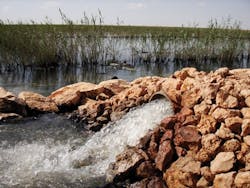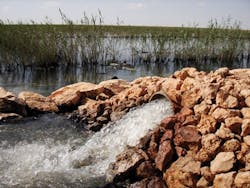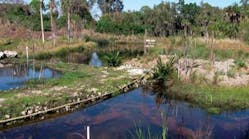By Kathy Worley and Frank Feeney
After nearly seven decades of neglect and destructive development, the Conservancy of Southwest Florida, along with Florida Department of Environmental Protection, the City of Naples, South Florida Water Management District, and Collier County, is taking a holistic approach to reducing stormwater runoff and as a result is improving the effectiveness of the Naples Bay watershed.
Prior to 1940, Naples Bay was a shallow mangrove-fringed estuary that supported oyster and seagrass beds and estuarine fauna. Its watershed covered approximately ten square miles. Extensive dredge and fill operations and urban development in the 1950s and ‘60s significantly changed the character and function of the watershed. The changes resulted in a considerable loss of mangroves and oyster beds and almost complete decimation of the sea grasses. The natural tributaries and associated infrastructure of the historic flow ways to Naples Bay and its biology were significantly impacted.
A tremendous amount of freshwater drained into the Naples Bay via the Gordon River after the completion of the extensive Golden Gate canal system and the installation of other stormwater drainage conveyances used to drain wetlands for urbanization and stormwater runoff (flood control). The result: the Naples Bay Watershed increased tenfold in size to approximately 120 square miles.
Over the years, more canals within the City of Naples and unincorporated urban sections of Collier County added even greater volumes of stormwater into Naples Bay. This anthropogenic watershed alteration impacted the historic volume, quality, timing and mixing characteristics of freshwater flows into the Bay. These alterations and increases in freshwater reduced water clarity, increased concentrations of contaminants and nutrients, and reduced dissolved oxygen levels. Seasonal influxes of freshwater altered the natural salinity regime of the Bay, negatively impacting the survival and health of estuarine-dependant species. Severe declines in the benthic communities, including seagrasses and oyster populations, occurred. The combination of losses of both benthic and terrestrial vegetation (seagrasses and mangroves in particular) ricocheted through the higher trophic level organisms (i.e., fish) and caused their decline.
Conservancy of Southwest Florida: Filter Marsh Pollution Reduction Strategy
The purpose of the Conservancy Filtration Marsh Project was to reduce urban runoff pollution while enhancing the wildlife and education values of the site. The project used a series of stormwater Best Management Practices (BMPs) to treat urban runoff and reduce pollution loading to the receiving waters of the Gordon River. The BMPs selected for this project treat runoff through isolation of the most polluted volume of stormwater and the processes of sedimentation, adsorption, infiltration, biological uptake, microbial degradation, and volatilization. The project took advantage of the specific pollution removal capabilities of different BMPs combined to effectively treat stormwater.
“We selected BMP’s for this project for their ability to reduce nonpoint source pollutant loading,” said Andrew McElwaine, Conservancy of Southwest Florida President and CEO. “Our goals were multi-faceted.”
Figure 1: Before the project the ditch that ran through Conservancy property was steep-sided and constrictive to stormwater flow.
McElwaine outlined the goals:
- Reduce annual stormwater runoff volume and pollutant load discharges to improve water quality.
- Increase use and diversity of the site by native species and improve the site’s ecological value by adding wetland vegetative cover and removing exotics.
- Assess the pre- and post-construction nutrient loading, hydrologic regime and wildlife use.
- Increase public awareness of water quality problems associated with stormwater runoff.
- Illustrate the benefits and aesthetic qualities of filter marshes to the public and Conservancy of Southwest Florida guests.
Project Design
Within the Gordon River South sub-basin, an existing drainage ditch allowed stormwater runoff to flow from a regional mall’s parking lot, a major road, and adjacent residential areas with minimal to no treatment. The ditch bisects the Conservancy property before it discharges into the Gordon River. To reduce pollutants and decrease the volume of stormwater runoff, the Conservancy stormwater project was designed to intercept the stormwater flow in the drainage ditch and divert the flow into a wet detention pond, which drains through a filter marsh prior to discharging into the river.
Figure 2: After construction the water has a greater area to flow. Littoral plantings provide additional treatment.
Cap rock serves as a diversion structure used to divert the first flush portion of storm drainage into the wet detention pond and filter marsh. The elevation of the cap rock is set to allow a storm’s first flush to flow into the filter marsh for treatment. Higher storm stages will overflow the cap rock and continue downstream. By preventing excessive runoff from major storm events from entering the filter marsh, this type of diversion structure will prevent hydraulic overloading of the system and a reduction in its efficiency.
From the diversion structure, stormwater flows into a permanent wet detention pond. The pond slows the velocity of stormwater entering the system, allowing suspended solids to settle out. Larger and denser particles will settle out first, followed by the smaller and less dense particles. The pond is also capable of secondarily removing pollutants from stormwater by adsorption to sediments, microbial decomposition, and biological uptake. In addition to a permanent pool, the basin includes a planted littoral shelf. The littoral shelf comprises a minimum of 30 percent of the surface area of the basin and is planted with native wetland vegetation. While reducing erosion, the shelf enhances the biological uptake of pollutants by plants, prevents resuspension of sediments, and increases the habitat and aesthetic values of the filter marsh.
The outlet of the sedimentation basin provides sheet flow into the constructed wetland/filter marsh portion of the treatment train. Wetlands remove pollutants from water through a variety of processes including sedimentation, adsorption, biological uptake, microbial decomposition, volatilization, and infiltration to some degree. Biological uptake occurs as nutrients, metals, and other contaminants are assimilated into the plants. Microtopography within the wetland increased the habitat diversity while acting as check dams, increasing the hydraulic residence time and efficiency of the BMP.
Figure 3: The crescent-shaped cap rock diversion structure is delineated by the temporary irrigation pipe. The cap rock elevation difference forces the water to slow down prior to entering the wet sedimentation pool, allowing for additional stormwater treatment upstream.
Within six months of the end of construction, the filter marsh and sedimentation basins have proven to be a valuable habitat: a variety of fish, including juvenile snook, now call it home and Southwest Florida’s herons and other wading birds have found a new hunting ground.
Other improvements included widening and decreasing the slope of the existing stormwater drainage ditch to reduce erosion of the ditch banks during high flow events. A new, large box culvert improved ditch flow characteristics and replaced an existing drainage culvert, which had historically overtopped during severe storm events. The drainage ditch was analyzed with HEC-RAS to see the effects the improvements would have on the existing condition during the permitting phase of the project. The results of the analysis showed that upstream head conditions were reduced dramatically by removing the existing triple 19’’ x 30’’ ERCP ditch culvert and replacing it with a 5’ x 7’ box culvert. These types of BMP improvements will reduce erosion of the ditch side slopes during high flow events, decrease the risk of upstream flooding, provide a littoral zone for further improved wildlife habitat/foraging, and provide additional treatment of the stormwater runoff.
Monitoring and Assessments
An analysis of project effectiveness of BMP implementation is currently underway. The analysis includes evaluating pollutant load reduction effectiveness of each individual BMP (ditch alterations, wet pond detention, and filter marsh) through water quality analysis. Hydrologic and biological assessments are being performed. Hydrologic components of the monitoring plan include flow and volume assessments pre- and post-treatment. Biological assessments of the faunal makeup of the area pre- and post-construction will determine the effects of this project on fish and anuran aquatic communities and avian use of the constructed resource. The anticipated ecological benefits of this project to wildlife will accentuate the importance and ecological value of the creation of refugia for these species in developed areas.
The monitoring components of this project address BMP elements that will document the effectiveness of combining three different stormwater treatment alternatives in a treatment train approach over a three-year period which began in November 2009. The evaluation of data collected during water quality monitoring will be useful in improving estimates of nutrient loading, resulting in better management decisions on future projects.
The biological assessment monitoring component of this project will help in understanding the link between water quality and actual data on the current status of the biota within a constructed wetland. Fish, anuran and avifaunal communities serve as indicators of water quality conditions on both spatial and temporal scales. Basic information on the aquatic community structure, when coupled with a careful analysis of the water quality, will provide a more complete picture of the benefits (and/or negatives) of filter marshes in particular.
The integration of water quality data with biotic response variables is critical to having a complete and comprehensive understanding of implementing BMPs by increasing our technical understanding of the resource value of constructed stormwater treatment areas and will provide a comprehensive method for assessing the effectiveness of current stormwater BMPs.
“The Conservancy Filter Marsh Project integrates with our mission to protect the region’s water, land and wildlife and has become a signature project for our organization,” explained McElwaine. “This is the first of two filter marshes for our Nature Center as part of our Sustainability Initiative. These sites will demonstrate the benefits of good water quality and the enhanced aesthetics of incorporating filter marshes into our plans. Fundamentally, what was once a ‘dead ditch’ has been transformed into a wildlife and water filtration oasis.”
The Conservancy Filter Marsh site also functions as an “outdoor lab” for students to explore BMPs and analyze water quality. Over 600 third grade students visited the Conservancy Filter Marsh in the fall of 2009 and utilized it as a living laboratory to learn about pollution, perform water quality tests, survey wildlife and more. The success of this program has led to plans for a live video conference pilot program with third grade students at a local elementary school.
The Conservancy of Southwest Florida plans to add educational kiosks where guests can learn the purpose of wet detention ponds and filter marshes, their role in the reduction of stormwater pollutants, the benefits of BMPs in improving water quality and how they can be incorporated into their everyday lives.
About the Authors
Kathy Worley is the Co-Director of Environmental Science and Senior Biologist at the Conservancy is Southwest Florida. She can be contacted at (239) 403-4223 or via e-mail at [email protected]. Additional information about the Conservancy of Southwest Florida and the Sustainability Initiative is available at www.conservancy.org.
Frank Feeney, P.E., LEED AP, is a project manager with the consulting firm of Hole Montes Inc., the engineer of record for The Conservancy of Southwest Florida. He can be contacted at (239) 254-2000 or via e-mail at [email protected].





